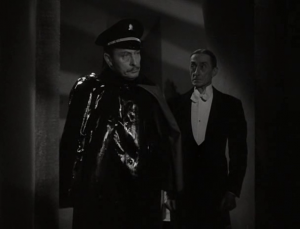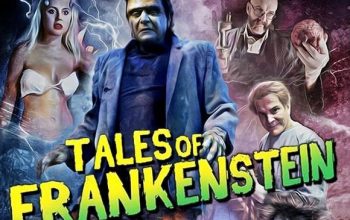Son of Frankenstein – 1939
You were hereafter to be hailed as the benefactors of your species, your names adored as belonging to brave men who encountered death for honour and the benefit of mankind. – Mary Shelley, Frankenstein
He’ll find no friends here. Nothing but locked doors and darkened windows. Locked hearts and bitter hatred. Let that too be part of the Frankenstein heritage – Village Councillor, Son of Frankenstein.
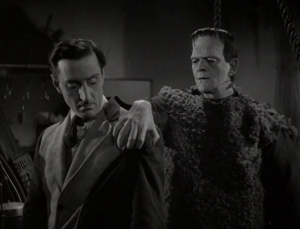
I hadn’t really wanted to do this one just yet. But my scheme of skipping around through has meant that I haven’t gone into a lot of detail on two important issues of the Frankenstein mythology: the Frankenstein family and Ygor. Both of these elements are introduced in Son of Frankenstein, so I’d probably better get on with it.
In the village of Frankenstein, Castle Frankenstein is closed up, shunned by the superstitious villagers. Its laboratory building is thought to inhabited only by Ygor (Bela Lugosi). The Frankenstein village council is unhappy to note the return of Wolf von Frankenstein, Henry’s son and the new baron. The council believe that this new Frankenstein will carry out his father’s work, nevertheless they agree to meet him at the station and deliver his father’s papers.
Wolf Frankenstein (Basil Rathbone), his wife Elsa (Josephine Hutcheson) and son Peter (Donnie Dunnagan), arrive in the village. Wolf fails to win over the villagers. Wolf and family set up their new home in castle Frankenstein. Inspector Krogh (Lionel Atwell) arrives. Krogh has a prosthetic arm, the original having been torn from him by the Monster. He warns of a series of unsolved murders that are being blamed on the ghost of the Monster.
Ygor confronts Frankenstein and tells his story. Ygor was a grave robber, who somehow survived hanging for his crimes. He shows Wolf the Monster, who survives, barely alive.
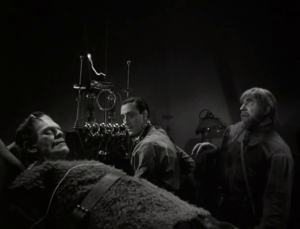
Wolf and Ygor attempt to revive the Monster, without success. It is implied that Ygor has been manipulating the Monster into killing the jurors who condemned him to death. Wolf goes off to confront Ygor, but comes face to face with the Monster in a silent encounter that is one of the highlights of the movie; Wolf struggling to overcome his obvious terror while the Monster struggles to understand the connection he feels to this mysterious newcomer.
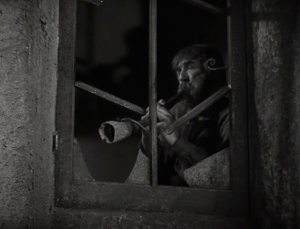
The Monster kills the last juror at Ygor’s behest. Now the town is in an uproar. Seven murders? That’s fine. It happens. But eight murders? Time for a riot! The Inspector warns Wolf as the villagers approach the castle, meaning to kill Ygor and probably Wolf as well.
Wolf begins to unravel, and Elsa realises something is up. Wolf confronts Ygor again in the lab, this time armed. Ygor tries to kill him, and is shot dead. Krogh goes in search of the Monster, discovering Benson’s body in the secret passages that Ygor has been using to get into the castle.
The Monster if horrified at the death of Ygor, and goes on a rampage. Wolf confesses to Krogh about killing Ygor. The Monster kidnaps Peter, stealing him away into the lab. Krogh follows the monster and a fight ensues. The Monster pushes Peter out of the way. Wolf swings down on a rope, knocking the Monster into the sulphur pit.

Wolf gives the castle over to the villagers who have stopped rioting and are pleased with the gesture. The Frankenstein family departs to safety.
Son of Frankenstein is a mixed bag. Overlong, and not as brilliant as its two preceding Frankenstein films, it’s still pretty good in its own right. The technical aspects of the filming are excellent. The Castle Frankenstein interiors are hugely impressive, a strange and wonderful mix of Art Deco and Expressionist elements.
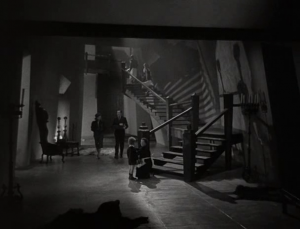
Basil Rathbone’s Wolf is a very unusual take on Frankenstein. He’s more self-assured and less twitchy than Colin Clive’s Henry Frankenstein, warmer and more human than Peter Cushing, Rathbone presents us with a Frankenstein who is dangerous because he isn’t mad. Unlike other Frankensteins, Rathbone gives the impression that he actually understands and even cares about the consequences of his actions, but goes ahead anyway. The gradual erosion of his self-assurance as he gets in deeper and deeper is beautifully done. It’s not my favourite portrayal of monster-maker, but it’s a unique one and Rathbone has the charisma to carry it off while still coming across sympathetically. The unfortunate part of his casting is that Rathbone is very tall. Even in his heavy Frankenstein shoes, Karloff is barely taller than him, and this takes some of the menace out of their encounters.
Karloff does his best with his scenes as the Monster. After Son, he quit the role, believing that he had nothing more that he could add to it. He was probably right to think so. His first encounter with Wolf manages to recapture some of the old magic, but other than that he seldom hits the heights of Frankenstein or Bride. His portrayal of the Monster is less sympathetic and more… well, more monstrous than before. It’s still very effective, and he bows out on the role that made him famous on a high note.
Lionel Atwell has a splendid time hamming it up as Inspector Krogh. Many of the best scenes in the film are his confrontations with Wolf. The other performances are less impressive. Josephine Hutcheson does what she can with scant material as Elsa von Frankenstein. The councillors are mostly pretty unimpressive. And Donnie Dunnagan–best known as the voice of Bambi–is, not very… Is it wrong to criticise a small child for being untalented? Probably it is. I’ll just stop there.
There are three elements of Son of Frankenstein that I want to look at in more detail Ygor, the idea that the Monster is indestructible and the concept of the Frankenstein family curse. While Son of Frankenstein might get short shrift as the least of the three Karloff Frankensteins, it is through these elements that the movie casts a long shadow over the Frankenstein mythos.
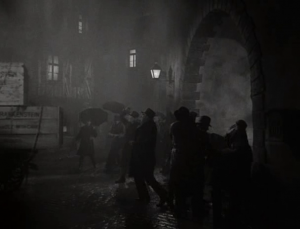
‘What do we want?’ ‘To riot!’ ‘When do we want it?’ ‘To riot!’
Ygor: If you get nothing else from watching this movie, at least enjoy Bela Lugosi having the time of his life. After Dracula, Lugosi was desperately typecast—not so much as a vampire, a role he rarely played, but as an aristocratic villain. Like so many typecast actors, he clearly relishes a role even a little outside of the ordinary. As Ygor, the uncouth blue-collar schemer, Lugosi chews is chewing a different sort of scenery than usual, and his joy in this is obvious.
But who is Ygor? The usual conception of Ygor,, comes partly from Fritz in Frankenstein (1931). A character modeled on Fritz but going by the name ‘Igor’ turns up in Mel Brooks’ Young Frankenstein. The lisp that Charles Laughton used when playing Quasimodo helps create the finishes subject.
The Ygor in Son of Frankenstein may have donated his name to a horror archetype, but he bears little resemblance to that archetype. He is not a hunchback. His lopsided shoulders are the result of the broken neck from his botched hanging, rather than curvature of the spine. Ygor does not assist in the creation of the Monster, and he certainly does not call Frankenstein his ‘Master’, or even ‘Mathter’. Ygor is a villain in his own right with his own agenda — not as brilliant as Frankenstein, but cunning and ruthless. In spite of his death in Son, he goes on to reappear in Ghost of Frankenstein, though his fate after that is murky indeed.
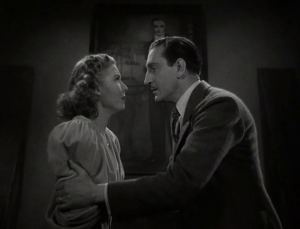
The Frankenstein Family: Early in the film one of the old councilors claims that Wolf is bound to follow in Henry’s footsteps. “It’s in the blood,” he says. At this point, there is precisely zero evidence for this assertion. Henry’s folly we know, but Henry’s father was a gruff old duffer who gave no suggestion that he was interested in science, let alone forbidden science.
Yet the councilor is correct. Wolf has to have a bash at Monster science, and people die as a result – although, remarkably, the villagers accept his redemption and he departs as a friend. In the next Frankenstein film, Ghost of Frankenstein, another of Henry’s sons gets involved with the Monster. In later films, Frankenstein’s daughter (Frankenstein Island, Santo vs Frankenstein’s Daughter, ) grandson (Young Frankenstein), aunt, great grandson (Struck By Lightning) and great great great etc grandson (The Frankenstein Theory) all get in on the act.
This is, not to put too fine a point on it, weird. One of the minor themes of the original novel is that Frankenstein’s unnatural creation is utterly destructive to the Frankenstein family (ie, the usual system for making more people). Frankenstein’s brother and wife are both killed by the Monster and Frankenstein himself dies childless. The idea of the Frankensteins being genetic mad scientists directly contradicts Mary Shelley’s ideas.
Yet somehow the idea sticks. Somehow the idea that monster making is a family curse is such an attractive one that we keep coming back to it. Even the Monster seems in on the act, seeming to sense some sort of connection with Wolf and Peter — who, after all, are effectively his brother and nephew. When the Monster kidnaps Peter, there doesn’t seem to be any malice involved. He does not harm the boy, and even pushes him to safety while fending off Krogh. It is almost like the Monster is seeking companionship with a relative after the death of a friend.
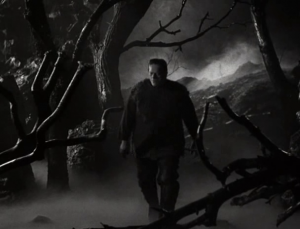
The Monster’s indestructibility: The previous Frankenstein films all work on the assumption that the Creature can be destroyed. The Monster is strong and tough, but not necessarily superhuman. In Son, Wolf proclaims that the Monster is essentially immortal. It has two bullets in its heart and yet it lives. It can be rendered dormant, but never destroyed. In the climactic fight, Krogh shoots the Monster multiple times at close range, to no obvious effect.
While not every subsequent Frankenstein movie has followed this idea, the idea of the Monster as being indestructible/immortal begins here.
I bring these three things up, because they’re important in the next few essays I’ll be doing. Over the next few weeks, I’ll be looking at Santo vs Frankenstein’s Daughter, which of course plays off the issue of the Frankenstein family; Victor Frankenstein, which presents us with a re-imagined Ygor and Frankenstein: the True Story which goes perhaps the furthest into the Monster’s invulnerability.
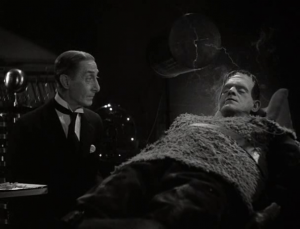
Finally, a thought on continuity. I don’t want to get too stuck on this one. Disparities between Bride of Frankenstein and Son of Frankenstein are easily explained by people — both creative people at the studio and the public in general — simply not caring. As long as the main elements of the previous story line up, why worry about the details?
Having said that, let’s worry about the details. Son takes place several decades after Bride. It doesn’t look it, because the designs of both films are contemporary, but never mind that. Let’s say Frankenstein takes place around the turn of the century, Bride a few months later, and Son in the surprisingly peaceful Europe of 1939. What exactly has happened in the intervening years? The film implies that Henry Frankenstein’s monster making ended with the laboratory explosion at the end of Bride. And yet the laboratory shown here is much closer to Castle Frankenstein as well as being the wrong shape and size–to say nothing of the fact that it suddenly contains a family tomb and a sulphur pit.
Then there’s the attitude of the villagers. In Frankenstein, the villagers didn’t seem to hold Henry’s experiment against him. In Bride they didn’t even know what he was up to. In Son, we see the villagers are unanimous in their hatred of Henry’s entire family. What’s more, Krogh’s description of the Monster’s rampage implies a great deal more malicious damage than shown in either of the first two movies.
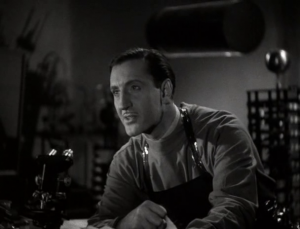
Wolf was brought up in England by his mother. Is this Elizabeth? Was this before or after Henry died? When did he die? None of these things are clear. A letter from Henry to his son suggests a man unrepentant, willing to continue his work and happy for his son to take up his work after he is gone.
The obvious conclusion is that in between Bride and Son, Henry Frankenstein finally stopped dithering and turned full evil. Emboldened by the villagers’ lackadaisical approach to his previous mockeries of the laws of nature, he built a new laboratory closer to home – on top of his family’s crypt, no less. Perhaps the Monster’s newfound power was deliberately bestowed?
But something went wrong. The Monster ran amok, more malicious and violent than ever before. Elizabeth was forced to flee the country, the laboratory was destroyed, supposedly killing the Monster. Henry probably died at this time or shortly after. Robbed of their vengeance, the villagers turned on a Ygor, a grave robber who was (rightly or wrongly) suspected of procuring parts for Henry. Ygor was hanged, and the rest is history.
That’s the obvious conclusion, anyway. So it probably isn’t right.
